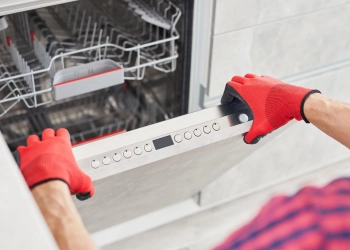In our modern lives, appliances are indispensable tools that streamline our daily tasks. However, when these trusty devices malfunction, it can disrupt our routines and cause frustration. From a leaking dishwasher to a malfunctioning refrigerator, appliance breakdowns present challenges that many homeowners dread.
But fear not! With the right approach and knowledge, navigating appliance repair challenges can lead you from a state of panic to a sense of mastery over your household machinery.
Understanding Common Appliance Malfunctions
Before delving into the world of appliance repair, it’s essential to understand the common malfunctions that can occur. From electrical issues to mechanical failures, appliances can break down for a variety of reasons.
One of the most frequent problems is electrical faults, which can result from wiring issues or power surges. Mechanical malfunctions, such as broken seals or worn-out components, are also prevalent, especially in older appliances.
When your appliance starts acting up, the first step is to diagnose the problem accurately. Is your dryer not heating? Is your refrigerator leaking water? By understanding the symptoms of common malfunctions, you can pinpoint the root cause more effectively. Additionally, consulting the appliance’s manual can provide valuable insights into troubleshooting specific issues. Armed with this knowledge, you’ll be better equipped to tackle the repair process with confidence.
Gathering the Right Tools and Resources
Once you’ve identified the problem, it’s time to gather the necessary tools and resources for the repair. Having the right equipment on hand can make a significant difference in the efficiency and success of your repair efforts.
Basic tools such as screwdrivers, wrenches, and pliers are essential for disassembling appliances and accessing internal components. Additionally, investing in specialized tools designed for appliance repair, such as multimeters or appliance repair kits, can streamline the process and ensure precision.
In addition to tools, accessing reliable repair resources is crucial for navigating appliance repair challenges effectively. Online tutorials, repair manuals, and instructional videos can provide valuable guidance and step-by-step instructions for diagnosing and fixing appliance issues.
Furthermore, don’t hesitate to reach out to professional repair services or consult with experienced DIY enthusiasts for advice and assistance. With the right tools and resources at your disposal, you’ll be well-equipped to tackle even the most daunting appliance repair challenges.
Mastering DIY Appliance Repair Techniques
While some appliance repair needs may require professional intervention, many common issues can be addressed through DIY methods. Learning basic appliance repair techniques empowers homeowners to take control of their maintenance and save money on costly service calls.
Whether it’s replacing a faulty heating element in your oven or unclogging a dishwasher drain, mastering DIY repair techniques can transform appliance malfunctions into opportunities for learning and skill development.
One effective DIY strategy is to start with simple repairs and gradually tackle more complex tasks as you gain confidence and experience. Begin by familiarizing yourself with the inner workings of your appliances and practicing basic repair techniques on smaller, less critical items.
As you become more proficient, you can gradually work your way up to more challenging repairs, such as replacing motors or electronic control boards. Remember to proceed with caution and prioritize safety at all times, especially when dealing with electrical appliances.
Exploring Advanced Appliance Repair Techniques
While DIY repairs are suitable for many common appliance issues, some repairs may require more advanced techniques and expertise. As you gain confidence in your repair abilities, you may find yourself eager to explore more complex repairs and tackle a wider range of appliance malfunctions. Advanced appliance repair techniques often involve troubleshooting intricate components and conducting repairs that require specialized knowledge and tools.
One area of advanced appliance repair is electrical diagnostics and troubleshooting. Electrical issues can be particularly challenging to diagnose and repair due to the complex wiring and circuitry involved in modern appliances. Advanced techniques such as using multimeters to test voltage, resistance, and continuity can help pinpoint the source of electrical faults with precision.
Additionally, understanding schematic diagrams and wiring diagrams can provide valuable insights into the inner workings of appliances and facilitate more accurate diagnoses.
Another advanced repair technique is component-level repair, which involves repairing or replacing individual components within an appliance rather than replacing entire units. This approach requires a deeper understanding of the appliance’s internal components and may involve soldering, desoldering, or replacing electronic parts such as capacitors, resistors, or integrated circuits.
Component-level repair can be cost-effective and environmentally friendly, allowing you to extend the lifespan of your appliances and minimize electronic waste.
Embracing Sustainable Appliance Repair Practices
In addition to mastering advanced repair techniques, embracing sustainable appliance repair practices can help minimize environmental impact and promote a more sustainable lifestyle. Instead of automatically replacing malfunctioning appliances with new ones, consider repairing and refurbishing existing appliances whenever possible. Sustainable repair practices not only reduce electronic waste but also conserve valuable resources and energy used in the manufacturing and disposal of appliances.
One sustainable repair practice is refurbishing and repurposing old appliances for new uses. With a little creativity and ingenuity, you can breathe new life into outdated or non-functional appliances by repurposing them for alternative purposes. For example, an old refrigerator can be transformed into a backyard cooler or converted into a unique piece of furniture. By giving old appliances a second chance at life, you can minimize waste and reduce the demand for new products.
Another sustainable repair practice is promoting longevity and durability in appliance design and manufacturing. Encouraging manufacturers to prioritize quality, durability, and repairability in appliance design can help extend the lifespan of products and reduce the frequency of premature obsolescence. Supporting initiatives such as product stewardship and extended producer responsibility can incentivize manufacturers to take responsibility for the entire lifecycle of their products, from production to end-of-life disposal.
Conclusion: Empowering Yourself Through Appliance Repair Mastery
In conclusion, navigating appliance repair challenges requires a combination of knowledge, skills, and resources. By understanding common malfunctions, gathering the right tools and resources, and mastering DIY and advanced repair techniques, you can empower yourself to take control of your appliance maintenance and repair needs. Additionally, embracing sustainable repair practices can promote environmental stewardship and contribute to a more sustainable future.
From diagnosing electrical faults to repurposing old appliances, each step in the repair process brings you closer to mastery over your household machinery. So the next time you encounter a malfunctioning appliance, don’t despair – embrace the challenge, roll up your sleeves, and embark on a journey of discovery and empowerment through appliance repair mastery. With determination, perseverance, and a little bit of know-how, you can transform appliance breakdowns into opportunities for learning, growth, and sustainability.







